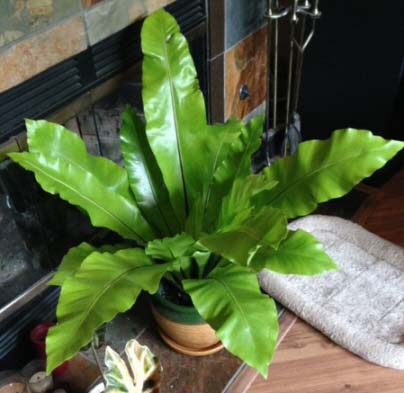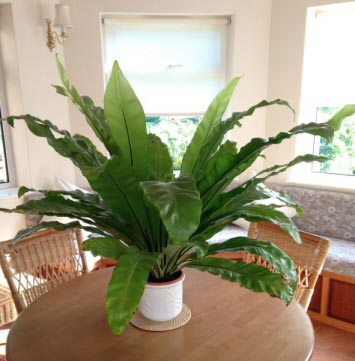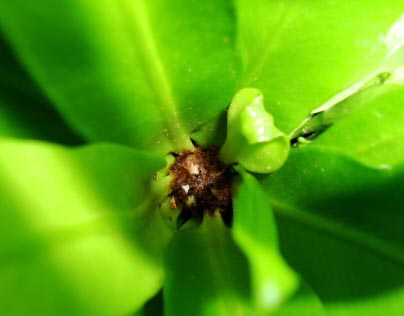





The Bird's Nest Fern or Asplenium nidus is one of the several popular and beautiful ferns grown as houseplants.  They can grow in North facing windows perfectly well and will truly relish the type of light and cooler temperatures these places receive. In return the plant will give you lots of naturally glossy leaves arranged in a circular pattern which resemble a bird's nest (hence the common name for these plants).
They can grow in North facing windows perfectly well and will truly relish the type of light and cooler temperatures these places receive. In return the plant will give you lots of naturally glossy leaves arranged in a circular pattern which resemble a bird's nest (hence the common name for these plants).
Bird's Nest Ferns have very few problems, are cheap to purchase and readily available. They are particularly good houseplants for bathrooms or a frequently used kitchen because these places tend to have a steamy atmosphere. This is important because a Bird Nest Fern needs some humidity to really thrive indoors, they will still cope and deal with an average room but for that extra shine and extra large size you need to be at least misting regularly.
Alternatively, if you don't have the time for all that misting, the Bird Nest Fern is an ideal plant to keep in a home terrarium or glass bottle garden, these enclosed spaces create naturally moist and protective environments that many types of plants, including most ferns, will do well in. The older glass bottle garden are a little old fashioned we'd admit, but as design pieces themselves they have started to become more popular again with interior designers. You may have a larger selection to pick from at car boot sales or in antique shops, but Amazon have a few of the more modern fashion trends to give you some inspiration. Take a look at the links below.
When it comes to what Bird Nest Ferns you can buy there is really only the common type and that is Asplenium nidus. As with most ferns it's difficult to create different cultivars, although you may still be able to find some which have curly or frilly ruffled leaves if you search hard enough. That said, the original is potentially the most beautiful looking anyway.
Light
Only medium light levels are needed for the Bird's Nest Fern to do well and if this can be at a consistent level over the day that's even better. This is in part why they make ideal investments for your tricky North facing windows, this type of light is loved by artists and by this houseplant. If you don't have such a spot or your rooms don't face exactly North just be sure to keep it out of direct burning sunlight and it should be fine.
Watering
You shouldn't be allowing the soil to dry out at all
Ferns often fail in homes because of the way they are treated when it comes to watering - either they get too much water or not enough. Although the odd slip up won't hurt, you need to try and work with your Asplenium nidus by keeping the soil just moist throughout the entire growing seasons (Spring, Summer and Autumn / Fall). This means you shouldn't be allowing the soil to dry out at all, but equally you mustn't water so much and often that the soil is soggy or wet.
In Winter you only need to water every few weeks at most, because the need for water drastically reduces at this time of year and a lot of unused water sitting around the roots will encourage rotting.
Humidity
Secret Tip - the key to growing a very large Bird Nest Fern is to focus on humidity. This plant loves a high level of moisture to really thrive in our homes and offices, which is another reason why they adore humid terrariums, sunrooms and conservatories.
You can of course still grow a more modest sized plant without specialist equipment, our humidity guide should give you some easy ideas and pointers.
Feeding
This fern is not very fussy when it comes fertilising (providing you don't over do it), but over a long period the leaves will dull and growth will come to a halt if you never provide any feed. It's best therefore to either feed very weakly once a month or so when in active growth, or at normal strength once every 6 months.
Temperature
Cool to average warmth is what you want to provide here. This is one of the few house plants which can struggle in really warm rooms so it might not be the best choice for a hot living room, snug or next to a radiator or fire. A temperature within the following range is needed for it to do well, 10°C - 22°C / 50°F - 72°F.
Repotting
It's time to repot when the thin roots completely fill the existing pot, once this has happened it's time to move it on into a slightly larger container.  If you don't, growth will stall before eventually stopping completely. As a rule of thumb a young Bird Nest Fern plant will need to be repotted once every year until it reaches a good size, after which you will only need to repot perhaps once every couple of years. However growth will depend on the growing conditions provided so be sure to check every 6 months or so. Bear in mind that even large plants can still do well in smaller pots (see picture) so there is no need to repot into a significantly bigger pot each time. Just be prepared to water more often as a smaller container will store less moisture.
If you don't, growth will stall before eventually stopping completely. As a rule of thumb a young Bird Nest Fern plant will need to be repotted once every year until it reaches a good size, after which you will only need to repot perhaps once every couple of years. However growth will depend on the growing conditions provided so be sure to check every 6 months or so. Bear in mind that even large plants can still do well in smaller pots (see picture) so there is no need to repot into a significantly bigger pot each time. Just be prepared to water more often as a smaller container will store less moisture.
Once you're getting your hands dirty with repotting the Bird's Nest Fern, you don't need to use or do anything particularly fancy. Standard potting soil is fine and if the roots are very compacted you might want to gently loosen them a little with your fingers. When you start planting it in, be sure that the crown is not buried - It must sit at the same level it sat at in the previous pot.
Propagation
Ferns, including the Asplenium will form spores in time which can be used to propagate new plants. Although we will give most things a try, propagating ferns using this method is not one of them. It's really difficult and you do need special equipment to pull it off successfully. So instead we'd rather spend a little money (because they are normally cheap plants anyway) and buy new ones if we want more.
Speed of Growth
Providing you are caring for your Bird's Nest Fern, growth will be quite rapid and regular during the growing seasons, new leaves will emerge from the central "nest".  A word of caution however - you must not handle the young fronds as they are emerging because they have a strong chance of becoming damaged and deformed if you do.
A word of caution however - you must not handle the young fronds as they are emerging because they have a strong chance of becoming damaged and deformed if you do.
Growth will be slow if the roots have no space to grow into or when the temperature is cold.
Height / Spread
A max height of 120cm / 4ft and a spread of 90cm / 3ft can be attained after many years but only in an environment that is very humid. Half these size estimates in a normal room.
Flowers
Does the Bird's Nest Fern have flowers? The answer to this is no it doesn't. This houseplant is all about the lush tropical and tranquil looking foliage.
Anything Else?
Ferns are sensitive to chemicals so you must avoid leaf shine products to prevent problems. The leaves are naturally glossy anyway, but of course if they start to dull from dust you can just pop it under a warm shower for a minute or two to wash the grime away.
Copyright © www.100flowers.win Botanic Garden All Rights Reserved